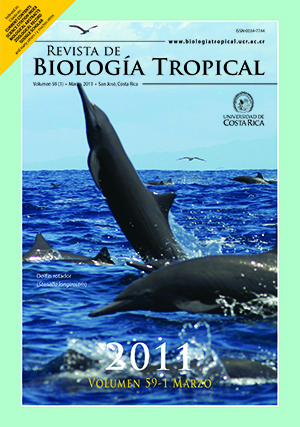Resumen
In tropical and subtropical regions of the world, parasitic diseases are a main cause of losses in livestock productivity. The increased acquired resistence to anthelmintics by gastrointestinal nematodes, requires biological control be considered as a potential feasible and effective alternative. The most effective natural soil enemies of nematodes are nematophagous fungi. In order to collect and identify predator nematophagous fungi (PNF), samples were obtained from 51 farms distributed throughout the seven provinces of Costa Rica. The origin samples included: soil from different crops (potatoes, tomatoes, bananas, ornamental plants, squash and coffee); animal feces (cattle, sheep, goat and horse); soil and fallen leaves from forest; and plants with signs of nematode infection. Each sample was processed using three techniques for the extraction of fungi from soil: sprinkling technique, soil dilution and humidity chamber. Twenty four strains of nematophagous fungi were found in 19 farms; 83.3% of the fungi were isolated by sprinkling technique. The following fungi were idenified: Arthrobotrys oligospora (n=13); Candelabrella musiformis (n=9); and for the first time there was isolation of A. conoides (n=1) and A. dactyloides (n=1) in the country. Moreover, 16 strains from Trichoderma (n=13), Beauveria (n=1), Clonostachys (n=1) and Lecanicillium (n=1) were obtained. In addition, pH of each possible fungal isolation source was measured, and it varied from 5.2 to 9.9, however PNF isolates fell within the range of 5.6 to 7.5. The PNF strains were cultivated in four different media for the production of chhlamydospores: potato dextrose agar (PDA); corn meal agar (CMA); malt extract agar (MEA) and potato carrot agar (PCA). Out of these cultures, 95.8% of the strains formed chlamydospores primarily in the PCA. Of these strains, the profilic spore producers were subjected to ruminant artificial gastrointestinal conditions. A total of 14 fungi were tested, out of which 42.9% survived the digestive analysis. Neither A. conoides nor A. dactyloides were viable following the in vitro gastrointestinal test. The PNF isolated in this study demostrated an action against ovine and caprine gastrointestinal nematodes and are candidates for use in biological control of these organisms. Among these microorganisms, Candelabrella musiformis appears to be the most promising fungi for use as a biological control agent in Costa Rica. Rev. Biol. Trop. 59 (1): 37-52. Epub 2011 March 01.##plugins.facebook.comentarios##

Esta obra está bajo una licencia internacional Creative Commons Atribución 4.0.
Derechos de autor 2011 Revista de Biología Tropical
Descargas
Los datos de descargas todavía no están disponibles.






